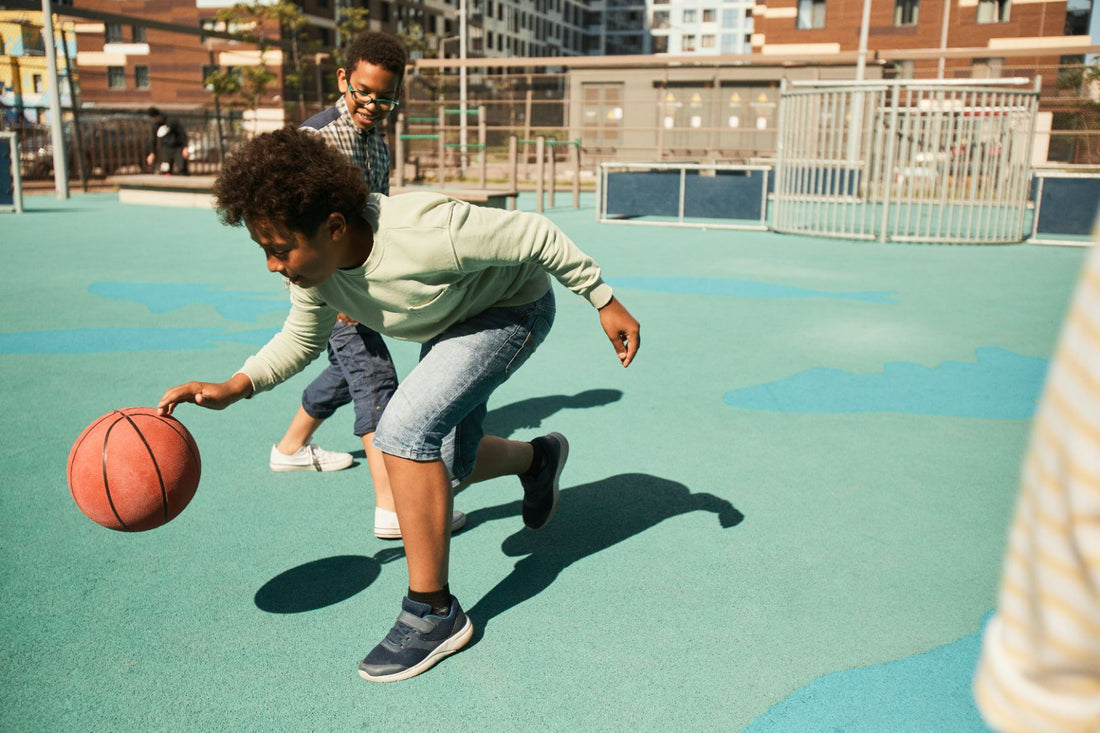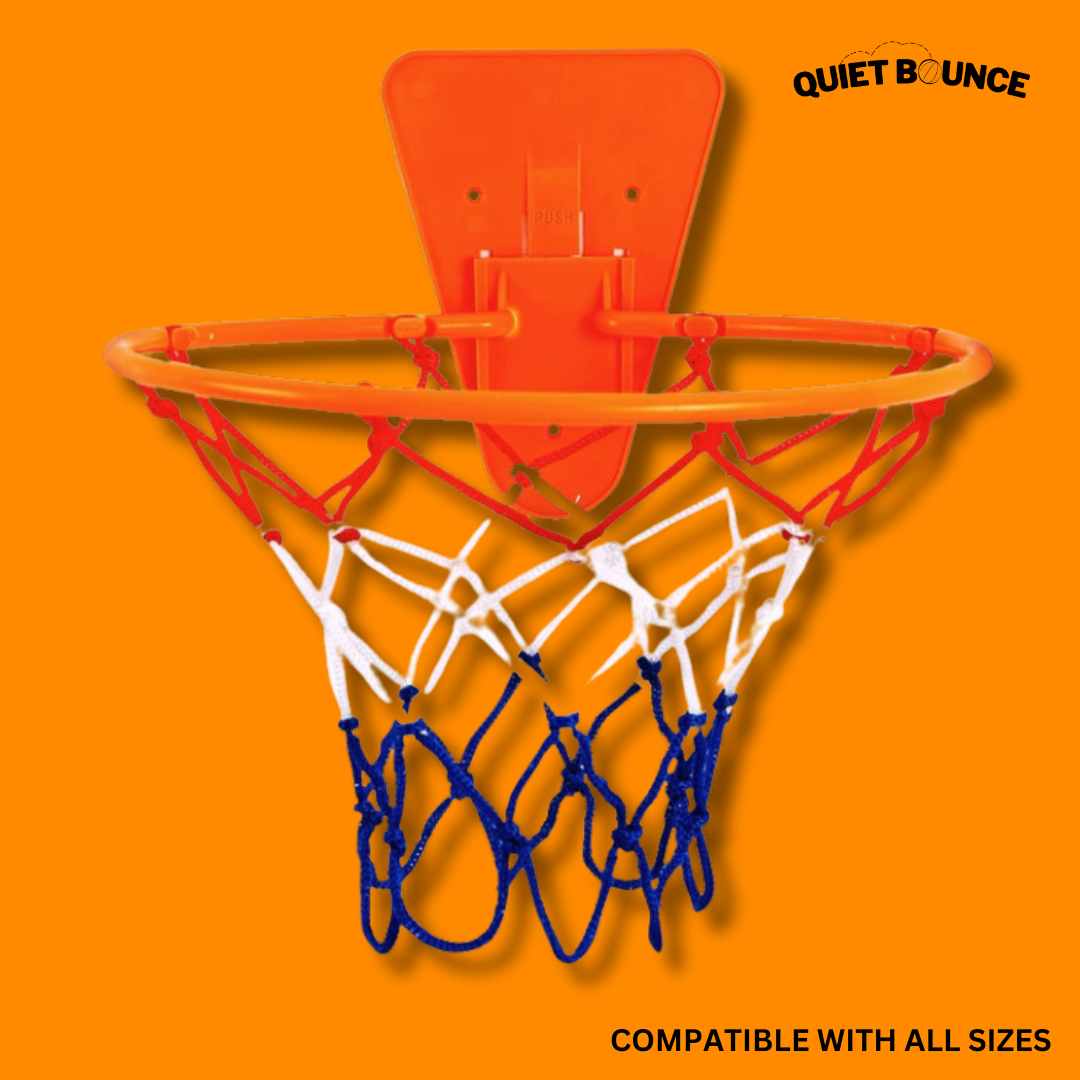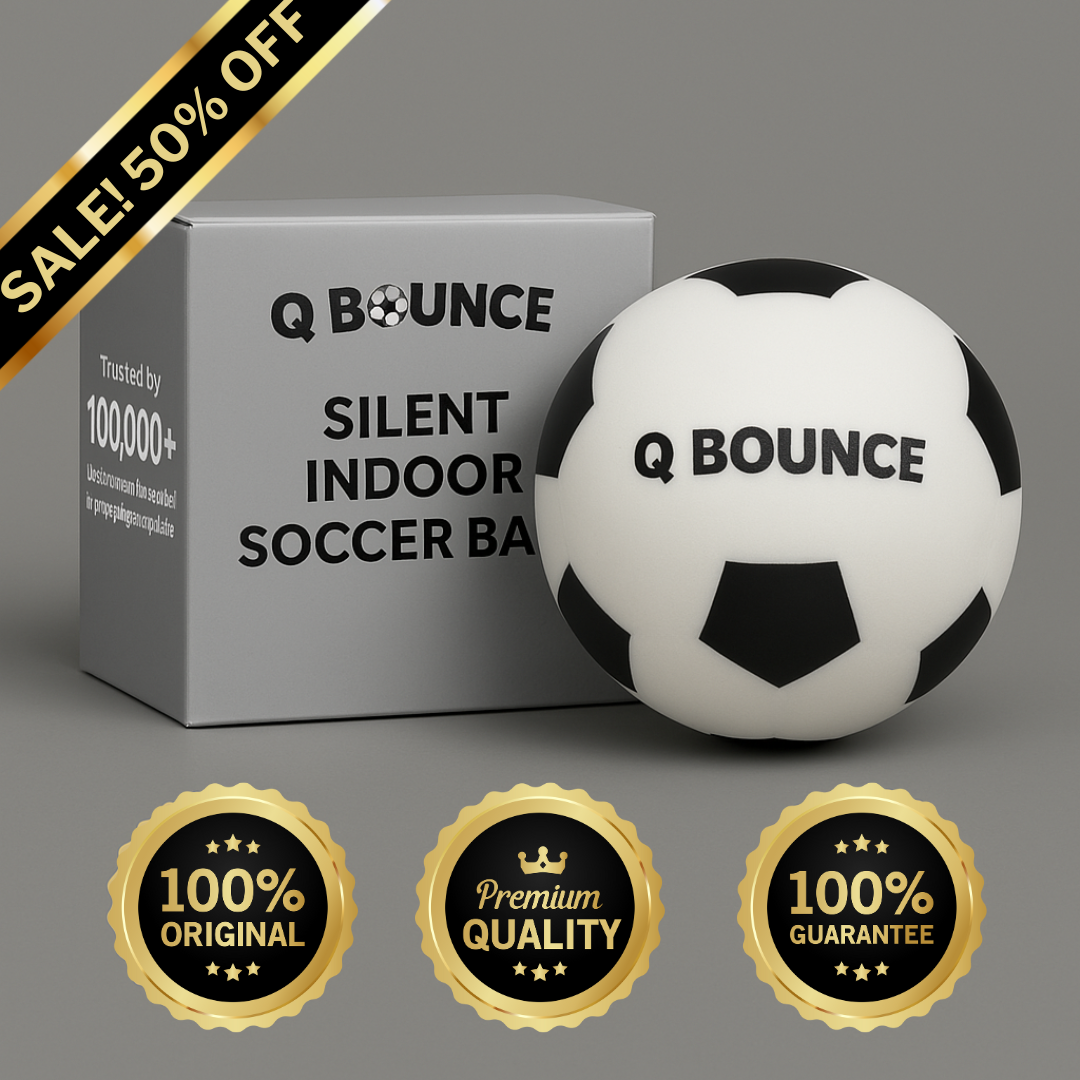
Best Basketball Dribbling Trainers
Share
Are you looking to take your basketball dribbling skills to the next level?
These trainers can help you improve your ball handling, coordination, speed, and overall control. From innovative devices like silent basketballs and smart basketballs to traditional tools like dribble sticks and resistance bands, there’s a wide range of options to suit all skill levels and training needs.
So, if you’re ready to become a force to be reckoned with on the court, keep reading to discover the best basketball dribbling trainers out there.
Silent Basketball
These specialized basketballs reduce the noise you generate when dribbling, allowing you to practice virtually anywhere. The softer rubber or synthetic material absorbs the impact of the ball hitting the ground, making the basketball quieter than a regular basketball. However, the size, weight, and grip are similar to a standard basketball, keeping the training experience realistic.
How to incorporate silent basketballs into your training routine
- Fundamental drills: Start by practicing basic dribbling exercises, such as stationary dribbles, crossovers, and between-the-leg dribbles. Focus on maintaining control and precision.
- Speed and agility drills: Incorporate drills that challenge you, such as dribbling through cones or around obstacles. The reduced noise will help you concentrate on your quickness and footwork.
- Game-like scenarios: Perform dribbling drills while simulating game scenarios, such as dribbling through defenders or executing pick-and-rolls. This will help you transfer your improved dribbling skills to real-game situations.
Dribbling Goggles
By limiting your vision, dribbling goggles challenge your ability to control the ball without constantly looking down, helping to develop your dribbling instincts and spatial awareness. The specially tinted lenses typically consist of lightweight and durable materials that are still comfortable and safe to wear during your training sessions.
How to incorporate dribbling goggles into your training routine
- Start with basic drills: Begin by performing stationary basketball drills. Focus on maintaining control of the ball and developing a feel for its movement without relying on direct visual feedback.
- Progress to dynamic drills: Once you feel comfortable with stationary drills, incorporate dynamic dribbling exercises that involve movement. Practice dribbling while changing directions, performing crossovers, or executing dribble moves. The goggles will challenge your ability to maintain control while you’re on the move.
- Add defensive elements: To simulate game-like scenarios, incorporate defenders or obstacles. This will further test your ability to read the court and make quick decisions while dribbling under limited vision.
Cones & Agility Ladders
Cones and agility ladders are essential for quickness, agility, and coordination. Incorporating these into your practice routine will train you to react faster when you’re on the court since they will challenge your spatial awareness and help you become more conscious of your surroundings.
How to incorporate cones into your training routine
- Dribbling drills: Set up a series of cones in a straight line or various patterns. Dribble the ball while maneuvering around the cones, working on your ball control, change of direction, and speed.
- Cone slalom: Arrange the cones in a slalom pattern and dribble through them as quickly as possible. This drill will help improve your ability to navigate tight spaces while maintaining ball control.
- Cone dribble moves: Place cones at different distances and heights to simulate defenders. Practice executing dribble moves such as crossovers, between-the-legs, and behind-the-back dribbles as you maneuver around the cones.
How to incorporate agility ladders into your training
- Ladder dribbling: Place the agility ladder on the ground and dribble the ball as you step in and out of the ladder's rungs. This drill will enhance your footwork, speed, and ball control.
- Lateral quickness: Stand beside the ladder and perform lateral movements through the ladder's rungs, such as lateral hops or shuffles. This exercise will improve your lateral quickness and help you stay in front of defenders while dribbling.
- Agility ladder drills with dribble moves: Combine agility ladder drills with dribble moves. For example, perform a crossover dribble at each ladder rung or execute between-the-legs dribbles while stepping through the ladder. This will enhance your ability to perform dribble moves in coordination with footwork.
Weighted Basketballs
Weighted basketballs are slightly heavier than regulation basketballs. The additional weight challenges your muscles, helping you to develop more extraordinary wrist and forearm strength. This translates to improved ball control and power on the court.
How to incorporate weighted basketballs into your training routine
- Warm-up drills: Begin your training session with basic warm-up drills using a weighted basketball. Perform stationary, fingertip control exercises, and figure-eight dribbles to get your muscles accustomed to the added weight.
- Dribbling drills: Incorporate drills that focus on ball control and strength. Perform dribbling moves, such as crossovers, between-the-legs, and behind-the-back dribbles. Gradually increase the intensity and duration of the drills as you become more comfortable with the added resistance.
- Strength and conditioning exercises: Perform specific strength and conditioning exercises. This can include wrist curls, forearm rotations, and finger squeezes to target the muscles involved in dribbling.
Dribble Sticks
Dribble sticks are adjustable, portable devices with multiple arms or bars attached to a base. These sticks simulate defenders or obstacles, forcing you to maneuver the basketball around them while maintaining control. These challenges will help you develop quickness, agility, and dribbling precision.
How to incorporate dribble sticks into your training routine
- Warm-up drills: Begin your training by performing warm-up drills using the dribble sticks. Start with basic dribbling moves, such as crossovers, between-the-legs, and behind-the-back dribbles, while maneuvering around the sticks. This will help you get accustomed to the added challenge and improve your dribbling technique.
- Dribble move variations: Once you feel comfortable with the basic drills, incorporate more advanced dribble move variations. While navigating through the sticks, experiment with different combinations of moves, such as between-the-legs crossovers or behind-the-back spin moves. This will help you develop a wide range of dribbling skills and improve your ability to create scoring opportunities.
- Speed and agility drills: Challenge yourself by performing speed and agility drills using the dribble sticks. Set up a course with cones and incorporate dribbling through the sticks as part of the drill. This will enhance your ability to dribble effectively while maintaining your speed.
Reaction Balls
Reaction balls are small, rubberized balls with uneven surfaces that cause unpredictable bounces. When you dribble or throw them against a hard surface, reaction balls bounce in various directions, challenging your reflexes and hand-eye coordination. These balls help you simulate game-like scenarios in which the ball may take unexpected bounces, helping you improve your ability to react quickly.
How to incorporate reaction balls into your training routine
- Dribbling drills: Start with basic stationary dribbling, focusing on maintaining control of the ball as it bounces unpredictably. Gradually progress to more dynamic drills, such as dribbling while moving or changing directions while reacting to the unpredictable bounces of the reaction ball.
- Hand-eye coordination exercises: Use reaction balls for specific hand-eye coordination exercises to improve your coordination and reaction time. This can include throwing the ball against a wall and catching it with one hand, alternating your hands with each catch.
- Reaction drills with teammates: Have a teammate throw the reaction ball to you while you dribble, and vice versa. This will simulate game-like scenarios in which the ball bounces in an unexpected direction, challenging your reaction speed and ability to change directions on the fly.
Bounce-Back Dribbling Nets
Bounce-back dribbling nets are nets or frames with a rebounding surface that allows you to practice dribbling while the ball returns. These nets simulate a defender's pressure by creating resistance when you dribble the ball against them. This provides a realistic training experience that helps improve your ball control and accuracy.
How to incorporate bounce-back dribbling nets into your training routine
- Stationary dribbling drills: Focus on maintaining control of the ball while dribbling against the net's surface. Practice various dribbling moves, such as crossovers, between-the-legs, and behind-the-back dribbles, to improve your ball control and technique.
- Dynamic dribbling drills: Perform drills while moving laterally, changing directions, or executing dribble moves. The bounce-back net will challenge your ability to maintain control and accuracy while on the move.
- Reaction and decision-making drills: Have a teammate or coach call out specific dribble moves or combinations and react while dribbling against the net. This will enhance your ability to make quick decisions and execute appropriate dribble moves in real-game situations.
Resistance Bands
Resistance bands are elastic bands made of solid and durable materials that provide resistance when you stretch them. They come in various resistance levels, allowing you to adjust the intensity of your workouts. You can use resistance bands to improve your strength and athleticism.
How to incorporate resistance bands into your training routine
- Dribbling drills with resistance bands: Attach a resistance band to a stationary object or have a training partner hold it. Perform different dribbling drills while against the resistance of the band. This will challenge your dribbling technique, strength, and control.
- Strength exercises: Use resistance bands for specific strength exercises that target the muscles used in dribbling. For example, perform wrist curls, finger extensions, or forearm rotations with the resistance bands. These exercises will help develop the necessary strength for powerful and controlled dribbling.
- Agility and footwork drills: Attach the band to your waist or ankles and perform dribbling drills while moving laterally or changing directions. The resistance will improve your lateral quickness and ability to change direction abruptly.
Smart Basketballs
Smart basketballs contain embedded sensors that track and analyze various aspects of your dribbling. These balls connect to mobile applications or devices via Bluetooth, allowing you to receive instant feedback on your dribbling technique, speed, control, and more.
How to incorporate smart basketballs into your training routine
- Assessment and analysis: Utilize the app or device to collect data on your current dribbling technique, speed, and control. Then, analyze the feedback to identify improvement areas and set specific training goals.
- Interactive drills and workouts: Follow the interactive training programs and drills the smart basketball app or device provides. These programs target specific aspects of your dribbling so you can improve your overall skill set.
- Progress monitoring: Continuously monitor your progress using the data and regularly assess your improvements. Adjust your training routine and goals to continue challenging yourself and pushing your dribbling abilities further.
Dribbling Gloves
Dribbling gloves feature textured surfaces or rubberized palms that provide a better grip on the basketball, allowing you to maintain control even in challenging conditions. Dribbling gloves are typically lightweight and breathable, ensuring comfort and flexibility during training sessions.
How to incorporate dribbling gloves into your training routine
- Dribbling drills: Start with basic stationary dribbles, focusing on maintaining control and improving your grip on the basketball. Gradually progress to more dynamic drills, such as dribbling while moving, changing directions, or performing dribble moves.
- Strength and control exercises: Perform finger taps or push-ups while wearing the gloves to improve your finger strength and agility. This will help you develop a firmer grip and better control of the basketball.
- Game-like scenarios: Practice dribbling against defenders or simulating specific game situations where you must maintain ball control under pressure. The gloves will boost your grip and power to navigate these situations successfully.
Whether a beginner or an experienced player, proper training tools can mean the difference between improving a little and a lot. But when leveling up your dribbling abilities, what’s most important is to have fun and challenge yourself.
So, choose tools you know you’ll enjoy using and will fit comfortably into your training program, and then strive to be consistent. The changes won’t come overnight, but if you stick with it, you will see results.




